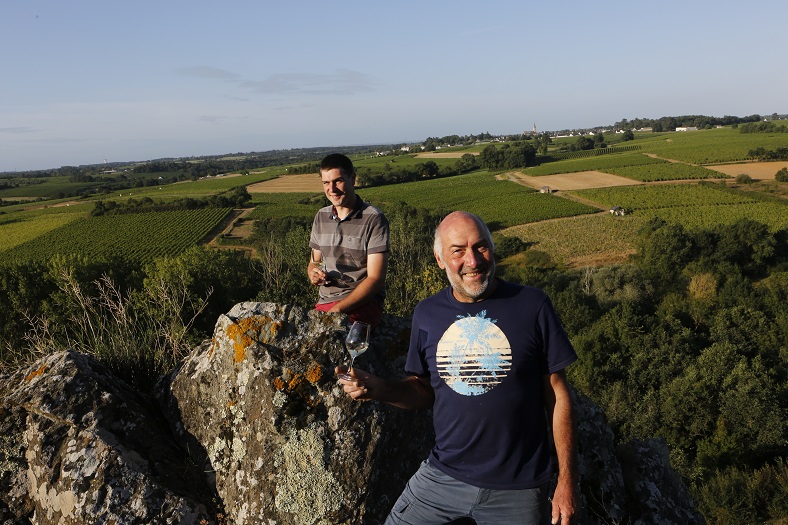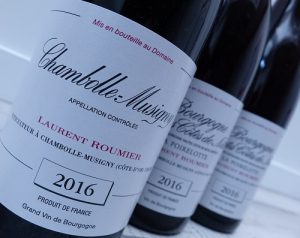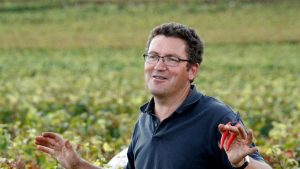
A world away from our Parisian office, Emmanuel Ogereau was absorbed in the task of pruning his vines when he answered the phone. But he was well up for a chat with us about his work on the estate, so here’s the lowdown on the domain and what goes on there.
Emmanuel Ogereau is the fifth generation of a family that has been in winemaking since the end of the 19th century. Humble as they come, he explains that this is a “history that goes way beyond [his family], the history of an ancient wine growing area and the birthplace of the Chenin grape”. Did he choose the life of a wine grower himself back in 2014, or did the vineyard have an irresistible pull? He couldn’t say. What Emmanuel does know, though, is that this vocation runs through his veins. Wine has the magical property of moving people, and then there’s the pleasure of being in touch with nature and its terroir. The work is tough, and nature can be cruel, but this isn’t an endeavour to let go of so easily; when done well, the satisfaction procured is like nothing else.
Let’s talk about the terroir. Situated in the Loire’s Coteaux-de-Layon area, near Savennières, the vines draw their character from a series of unique lieux-dits. Thriving here for over 1,000 years already, the Chenin grape grows in rich soils, as this part of the world owes its geological features to a mountain formation. A kind of earthy mosaic, the variety you’ll find under your feet around here includes aeolian sand, volcanic rock, pudding stone, sandstone, and schist.
Back at the domain, Emmanuel tells us about how each generation has made their mark on the history of the place. Whilst he considers himself “just a link in the chain”, he does have an objective in sight; to let the Chenin grape express itself in its full diversity. His parents made a speciality for themselves in their crafting of sweet and dessert wines. Emmanuel goes more for dry wines in his production, aiming to shine a light on terroirs with strong personality through replanting. All of the work in the vineyard is organic, with some biodynamic methods finding their way into the mix, too. Such a rich variety of soils, as already mentioned, should certainly not be neglected, hence the growth of plants whose roots form a nourishing layer of humus. There are also cows on site that are particularly helpful in their production of compost for the winter. Biodiversity is a key element of the estate’s wildlife, too, with a multitude of insects, worms, hares, starlings, buzzards, and bats all sharing and creating Domaine Ogereau’s thriving environment.
From this description, you’d be forgiven for thinking that Chenin grows in abundance, but this is actually quite a tricky and demanding grape. It requires top meticulous attention in order to do well, hence the seasonal team of harvesters who work alongside eight full-time employees and two apprentices in the vineyard. This is a lot for one producer, but it is what’s needed to precisely select the grapes by hand at perfect ripeness.
The particularity of the domain resides, as you may have noted, in its terroirs, especially for the effect these have on the resulting wines. The Chenin grape in Domaine Ogereau’s cuvées expresses itself far more on the palate than on the nose, for example. Tastebuds are thrilled by the balance of power and structure with vivacity and a beautifully bitter finish. The profiles of these wines differ mainly depending on the residual sugar levels present, ie. whether it is a dry or sweet cuvée. With his parents having focused on the sweeter side of things, much effort today goes into the perfecting of their dry range, with particular attention paid to gentle vinification and long maturation: “The terroirs talk,” Emmanuel explains “it’s not my job to tell them what they want.”
And does he have a few words to say about the domain’s dessert wines? Emmanuel admits that letting these cuvées fall from his attention has been a “huge mistake”. Far from cloying, these wines retain a real tautness, allowing for gorgeous pairings with spices dishes or pastries. “They’ve got the just the right kind of acidity and texture to serve with a simple poached peach or a tarte tatin!”
It was time to pose an all-important question: which of your wines has moved you the most? With such a collection of terroirs in his care, you’d think our vintner would have a hard time choosing. Actually, Emmanuel knows the answer straight away, and it’s the Vent de Spilite cuvée, a striking volcanic wine described with great verve. This cuvée comes from the Bonnes Blanches terroir, an area Emmanuel’s father replanted. And he mentions, too, the red wine made using very old vines that his grandfather planted there. A real family history that runs through the roots of the estate.



